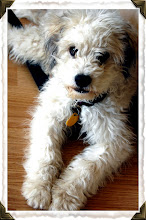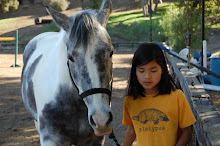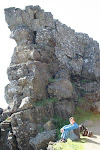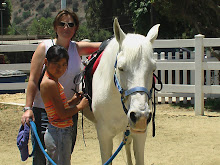August 12, 2009
Equine Clicker Training with Pat Lincourt: part one
Patricia Lincourt is an extraordinary horse trainer and riding instructor working in the Los Angeles area. Patricia owns and runs Lincourt Stables, a traditional hunter jumper barn at The Paddock Riding Club on Rigali Avenue. Ms. Lincourt has a lifetime of experience with horses and has trained and taught riding for many years. In addition to helping her students and horses to become the best show jumpers that they can be, Patricia has recently added a new method to her training repertoire and is using it to great advantage with a few of the horses under her tutelage: clicker training.
The use of clicker training with horses is a relatively recent event in the horse world, but it is becoming an increasingly widespread and popular training tool. Many professional horse trainers as well as amateur horse owners have discovered that clicker training can produce some amazing results, if used correctly and consistently over a period of time. First developed by zoo keepers and handlers of marine mammals in wild animal parks, clicker training involves using a small hand-held clicker to make a defined and unique sound that is recognized by the animal as a marker of a specific behavior.
By clicking the instant the animal performs what it is being asked, the trainer can reinforce that behavior and then reward the animal with food, treats or play. Using the snapping noise of a clicker is more consistent and less confusing than vocal signals or voice commands because it doesn’t sound like anything else and isn’t used or overheard at any other time. To get an idea of what a clicker sounds like, think of a Purim grogger or that small metal toy that makes a cricket-like sound when pushed. Some clicker training involves a long pole with a soft rubber or foam ball at the end, called a target. The animal is asked to approach and touch the target with its mouth or flipper, in order to get a food treat or reward.
Clicker training to a target was developed to enable handlers and veterinarians to get close to and examine large animals such as dolphins, sea lions and killer whales, and encourage the animals to allow themselves to be touched and handled. Getting close to a large, powerful animal that spends most of its time in the water is a tricky but essential part of caring for marine mammals. Clicker training also provides mental and physical stimulation to highly intelligent and energetic animals in captivity. If you’ve ever seen a show at Sea World with a leaping dolphin or splashing killer whale doing tricks on cue for the trainer, it’s a good bet that clicker training was involved.
When she was given a very difficult horse to work with and discovered that conventional training methods were not doing the trick, Pat turned to clicker training. No amount of groundwork or gentling could convince Buddy, a six year old paint horse, to allow anyone to ride him or even get on his back without bucking them off. Cowboy-style techniques that tried to “break” the horse failed miserably. Even Parelli’s methods of using groundwork to join up with and gain the horse’s trust did not succeed, once a rider tried to get near Buddy’s back or into the saddle. Buddy’s owner was about to give up all hope and send the young horse out to pasture, when she asked Pat to give it one last try.
Lincourt decided to try clicker training when she found herself with a horse that did not respond to conventional training methods. Pat had heard about clicker training from a book by Shawna Karrasch, “You Can Train Your Horse to Do Anything.” Shawna had worked at Sea World as a marine mammal trainer for many years when she became interested in the possibilities of applying clicker techniques to horse training. No longer at Sea World, Shawna has worked as a horse trainer for professional show jumpers since 1995 and is the owner of and co-founder of "On Target Training." [Note: Shawna Karrasch's website can be found at http://www.on-target-training.com/]
Pat decided to teach herself how to clicker train using Shawna’s book and instructional video, hoping that she could turn Buddy around. She began training with the usual tools, a clicker and a target pole and food treats. Buddy turned out to be particularly challenging to train because he turned up his nose at all the usual horse treats. He hated carrots and scoffed at most other foods that were offered to him. With persistence and patience, Pat finally hit upon his motivation: anything with molasses! Armed with molasses-infused treats, she set out to gain the horse’s trust and try to calm down his fear and deeply-ingrained bucking behavior.
“Clicker training is not a quick fix,” Pat cautions. “It won’t work unless you take your time, move slowly and incrementally and do it with consistency.” She notes that her hunter-jumper students are not particularly interested in learning clicker training because of its slow progress and need for patience and absolute consistency of method. Buddy was not a complete success in Pat’s opinion because he didn’t become a completely calm and dependable riding horse. But he was able to allow her to get on him and learned not to buck her off.
Although she feels that she just didn’t have enough time to complete Buddy’s training before the owner decided to sell him, she does think his prospects were improved. Buddy became a much more trusting and less volatile horse, and given more time with him, Pat believes that he would have been a good prospect for pulling a cart or working as part of a team of horses that pull a stagecoach or wagon. It’s clear that he didn’t have much of a chance at all until Pat gave him her time and attention, and used clicker training to get his mind focused and calm, helping him to overcome fear and bad habits. Buddy was sold, though not as a riding horse, and was given a new lease on life, thanks to Pat.
To be continued....
The use of clicker training with horses is a relatively recent event in the horse world, but it is becoming an increasingly widespread and popular training tool. Many professional horse trainers as well as amateur horse owners have discovered that clicker training can produce some amazing results, if used correctly and consistently over a period of time. First developed by zoo keepers and handlers of marine mammals in wild animal parks, clicker training involves using a small hand-held clicker to make a defined and unique sound that is recognized by the animal as a marker of a specific behavior.
By clicking the instant the animal performs what it is being asked, the trainer can reinforce that behavior and then reward the animal with food, treats or play. Using the snapping noise of a clicker is more consistent and less confusing than vocal signals or voice commands because it doesn’t sound like anything else and isn’t used or overheard at any other time. To get an idea of what a clicker sounds like, think of a Purim grogger or that small metal toy that makes a cricket-like sound when pushed. Some clicker training involves a long pole with a soft rubber or foam ball at the end, called a target. The animal is asked to approach and touch the target with its mouth or flipper, in order to get a food treat or reward.
Clicker training to a target was developed to enable handlers and veterinarians to get close to and examine large animals such as dolphins, sea lions and killer whales, and encourage the animals to allow themselves to be touched and handled. Getting close to a large, powerful animal that spends most of its time in the water is a tricky but essential part of caring for marine mammals. Clicker training also provides mental and physical stimulation to highly intelligent and energetic animals in captivity. If you’ve ever seen a show at Sea World with a leaping dolphin or splashing killer whale doing tricks on cue for the trainer, it’s a good bet that clicker training was involved.
When she was given a very difficult horse to work with and discovered that conventional training methods were not doing the trick, Pat turned to clicker training. No amount of groundwork or gentling could convince Buddy, a six year old paint horse, to allow anyone to ride him or even get on his back without bucking them off. Cowboy-style techniques that tried to “break” the horse failed miserably. Even Parelli’s methods of using groundwork to join up with and gain the horse’s trust did not succeed, once a rider tried to get near Buddy’s back or into the saddle. Buddy’s owner was about to give up all hope and send the young horse out to pasture, when she asked Pat to give it one last try.
Lincourt decided to try clicker training when she found herself with a horse that did not respond to conventional training methods. Pat had heard about clicker training from a book by Shawna Karrasch, “You Can Train Your Horse to Do Anything.” Shawna had worked at Sea World as a marine mammal trainer for many years when she became interested in the possibilities of applying clicker techniques to horse training. No longer at Sea World, Shawna has worked as a horse trainer for professional show jumpers since 1995 and is the owner of and co-founder of "On Target Training." [Note: Shawna Karrasch's website can be found at http://www.on-target-training.com/]
Pat decided to teach herself how to clicker train using Shawna’s book and instructional video, hoping that she could turn Buddy around. She began training with the usual tools, a clicker and a target pole and food treats. Buddy turned out to be particularly challenging to train because he turned up his nose at all the usual horse treats. He hated carrots and scoffed at most other foods that were offered to him. With persistence and patience, Pat finally hit upon his motivation: anything with molasses! Armed with molasses-infused treats, she set out to gain the horse’s trust and try to calm down his fear and deeply-ingrained bucking behavior.
“Clicker training is not a quick fix,” Pat cautions. “It won’t work unless you take your time, move slowly and incrementally and do it with consistency.” She notes that her hunter-jumper students are not particularly interested in learning clicker training because of its slow progress and need for patience and absolute consistency of method. Buddy was not a complete success in Pat’s opinion because he didn’t become a completely calm and dependable riding horse. But he was able to allow her to get on him and learned not to buck her off.
Although she feels that she just didn’t have enough time to complete Buddy’s training before the owner decided to sell him, she does think his prospects were improved. Buddy became a much more trusting and less volatile horse, and given more time with him, Pat believes that he would have been a good prospect for pulling a cart or working as part of a team of horses that pull a stagecoach or wagon. It’s clear that he didn’t have much of a chance at all until Pat gave him her time and attention, and used clicker training to get his mind focused and calm, helping him to overcome fear and bad habits. Buddy was sold, though not as a riding horse, and was given a new lease on life, thanks to Pat.
To be continued....
Equine Clicker Training with Pat Lincourt: part two
On a recent weekday afternoon at The Paddock Riding Club, Pat Lincourt was kind enough to allow me to observe a brief clicker training session with one of her client's horses. Jake is a talented jumper from New Zealand. This large, athletic horse has been injured and unable to work; he's cooped up in his stall day after day, with a lot of pent-up energy. Even at his best, Jake has a tendency to bolt when turned out for exercise. Imagine the intensity and power that will be unleashed after weeks of layup in his stall.
Bolting is a common and scary issue for many horse owners. As the horse is being walked to the turnout paddock, it anticipates being allowed to run free, gets worked up just as the paddock gate is being opened, and starts to pull. The horse might take off before the handler can safely remove the halter, close the gate and get out of the way. It's a potential disaster in the making because the risk of injury to horse and handler increases over time. Jake's bolting needed to be corrected.
Patricia decided to try adding clicker training to Jake’s usual routine. She hoped that the mental stimulation of clicker training would help to keep the horse occupied, use up some of his excess energy, and allow him to focus on her instead of bolting when he is taken to his turnout paddock. Pat enters Jake’s stall and shows him the target pole. She has a treat pouch around her waist, but doesn’t put a treat in her hand just yet. Pat says “target” and waits for Jake to figure out that he is supposed to touch his nose to the end of the pole. If he does, she clicks, instantly – timing is crucial to mark the correct or wanted behavior – and then takes a treat out and offers it to Jake. Over time, Pat moves the target farther away from Jake, little by little, until he has to come to her in order to touch the pole.
Eventually, when the horse is successful most of the time, Pat moves the target pole to another location in the stall, and stands in a corner. When she says “target" this time, Jake will have to go over to the target pole, touch it, and then walk back over to where Pat is standing in order to get his treat. Progess takes place very slowly, and consistency is key. Clicker training requires many repetitions, but it's vital to take the time to cement behaviors before moving on.
Building slowly towards more complex cues is very important if you want the horse to learn and remember. Now, after a few weeks of training sessions, Pat can ask Jake to do something that involves moving away from or towards her, just by clicking. This means that Jake will be responsive to Pat from a distance, even if she doesn't have a lead rope or reins in her hand. She will have the ability to communicate with and direct the horse, without having to use a halter, bit or lunge line.
With patience, the training possibilities are virtually limitless. Imagine a horse that is afraid to climb up into a trailer, or just refuses to budge, and the ordeal it becomes to load that horse. With proper clicker training, that obstinate or fearful horse can be encouraged to move forward, no matter what, towards a target, in anticipation of a food reward. This conditioning will allow the horse to “forget” that it’s afraid of trailers, to move towards the target pole when asked, even if it’s placed inside of the trailer, and then receive a treat. You start slowly, asking the horse to take just one or two steps forward. Then move on to a more complex behavior, with lots of repetition, consistency and patience.
After several clicker training sessions, the horse can be directed to stand with all four hooves placed on a mat on the ground, and then to move forward onto the mat from an increasing distance away. Eventually the mat can be put inside the trailer, and the clicker and treat reward can be repeated. The horse will forget to focus on the fear of walking up into a trailer, but will respond instead to the clicker and the promise of the treat that he'll receive, once he's standing inside the trailer, on the mat.
Under the right circumstances and with enough time and dedication, clicker training can work wonders for a variety of common issues and behavioral problems in horses. Jake has learned to calm down and focus while getting much less exercise than he’s used to, and Patricia is confident that he will learn not to bolt into his turnout paddock, now that he pays attention to her when she clicks and treats.
After only a few weeks of clicker training, Jake is responding quickly to the cues and has become much more manageable and calm. Pat has started using a clicker and target pole with other horses in her barn and is already seeing improvement. While emphasizing that clicker training is not a "magic bullet" for resolving all behaviorial problems, Pat believes that with consistent work and lots of time and patience, it can become an effective and valuable addition to any horse trainer's repertoire.
To contact Pat Lincourt and Lincourt Stables:
Website: www.LincourtStables.com
E-mail: gone2horses@gmail.com
Tel: 818.822.0881
The Paddock Riding Club: http://www.thepaddockla.net/
Bolting is a common and scary issue for many horse owners. As the horse is being walked to the turnout paddock, it anticipates being allowed to run free, gets worked up just as the paddock gate is being opened, and starts to pull. The horse might take off before the handler can safely remove the halter, close the gate and get out of the way. It's a potential disaster in the making because the risk of injury to horse and handler increases over time. Jake's bolting needed to be corrected.
Patricia decided to try adding clicker training to Jake’s usual routine. She hoped that the mental stimulation of clicker training would help to keep the horse occupied, use up some of his excess energy, and allow him to focus on her instead of bolting when he is taken to his turnout paddock. Pat enters Jake’s stall and shows him the target pole. She has a treat pouch around her waist, but doesn’t put a treat in her hand just yet. Pat says “target” and waits for Jake to figure out that he is supposed to touch his nose to the end of the pole. If he does, she clicks, instantly – timing is crucial to mark the correct or wanted behavior – and then takes a treat out and offers it to Jake. Over time, Pat moves the target farther away from Jake, little by little, until he has to come to her in order to touch the pole.
Eventually, when the horse is successful most of the time, Pat moves the target pole to another location in the stall, and stands in a corner. When she says “target" this time, Jake will have to go over to the target pole, touch it, and then walk back over to where Pat is standing in order to get his treat. Progess takes place very slowly, and consistency is key. Clicker training requires many repetitions, but it's vital to take the time to cement behaviors before moving on.
Building slowly towards more complex cues is very important if you want the horse to learn and remember. Now, after a few weeks of training sessions, Pat can ask Jake to do something that involves moving away from or towards her, just by clicking. This means that Jake will be responsive to Pat from a distance, even if she doesn't have a lead rope or reins in her hand. She will have the ability to communicate with and direct the horse, without having to use a halter, bit or lunge line.
With patience, the training possibilities are virtually limitless. Imagine a horse that is afraid to climb up into a trailer, or just refuses to budge, and the ordeal it becomes to load that horse. With proper clicker training, that obstinate or fearful horse can be encouraged to move forward, no matter what, towards a target, in anticipation of a food reward. This conditioning will allow the horse to “forget” that it’s afraid of trailers, to move towards the target pole when asked, even if it’s placed inside of the trailer, and then receive a treat. You start slowly, asking the horse to take just one or two steps forward. Then move on to a more complex behavior, with lots of repetition, consistency and patience.
After several clicker training sessions, the horse can be directed to stand with all four hooves placed on a mat on the ground, and then to move forward onto the mat from an increasing distance away. Eventually the mat can be put inside the trailer, and the clicker and treat reward can be repeated. The horse will forget to focus on the fear of walking up into a trailer, but will respond instead to the clicker and the promise of the treat that he'll receive, once he's standing inside the trailer, on the mat.
Under the right circumstances and with enough time and dedication, clicker training can work wonders for a variety of common issues and behavioral problems in horses. Jake has learned to calm down and focus while getting much less exercise than he’s used to, and Patricia is confident that he will learn not to bolt into his turnout paddock, now that he pays attention to her when she clicks and treats.
After only a few weeks of clicker training, Jake is responding quickly to the cues and has become much more manageable and calm. Pat has started using a clicker and target pole with other horses in her barn and is already seeing improvement. While emphasizing that clicker training is not a "magic bullet" for resolving all behaviorial problems, Pat believes that with consistent work and lots of time and patience, it can become an effective and valuable addition to any horse trainer's repertoire.
To contact Pat Lincourt and Lincourt Stables:
Website: www.LincourtStables.com
E-mail: gone2horses@gmail.com
Tel: 818.822.0881
The Paddock Riding Club: http://www.thepaddockla.net/
Subscribe to:
Posts (Atom)
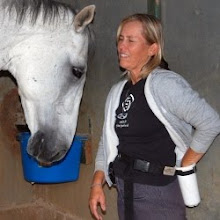.jpg)
